Paul Wightman, CME Group
The growth of the biofuels market is having a significant impact on the demand for key feedstocks with producers chasing the same supply. The International Energy Agency (IEA) predicts that the biofuels market will grow by nearly 20% between 2019 and 2026. These changes are one part of the overall drive to achieve net zero carbon emissions in the EU by 2050.
Competitive Pressures Push Feedstocks Higher
Strong renewable diesel (RD) demand has caused hydrotreated vegetable oil (HVO) and waste feedstock prices to rise, doubling over a 12-month period. Asian demand for soybeans is also resulting in less product being available for the soybean crush industry. U.S and Argentinian Soybean oil exports have been rising with total exports hitting 7.1 million tons in the 2020-2021 marketing year, up 7.5% in 12 months. Waste feedstocks prices such as used cooking oils and animal fats have seen significant price increases, partly on the back of reduced supply due to the coronavirus pandemic, which has resulted in much lower volumes of waste products collected from the restaurant and catering trade.Vegetable oil and waste products can be hedged via the futures markets to help the market manage price risk. Rotterdam Used Cooking Oil has become the globally relevant benchmark price and is also the underlying index to the CME futures contract.
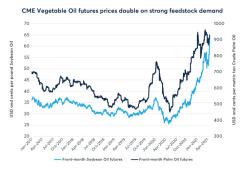
Source: CME Group data
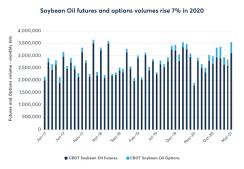
Source: CME Group data
Changing Dynamics of the Soybean Trade
The strength of Soybean Oil futures prices relative to Soybean Meal futures prices suggests that U.S. soybean crushing is likely being driven more by the demand for soybean oil than in the recent past. One question many are considering is whether this result is temporary or part of a longer-term trend supported by greater soybean oil demand. Soybean meal is used as high-protein animal feed while soybean oil is a vegetable oil used in various food, fuel and industrial applications. The demand for biofuels is changing the relationship between meal and oil, a key indicator for the soybean oil refiners.The Soybean Oil futures share of the soybean crush margin has recently hit the highest level in over five years, driven in part by the demand for feedstock for the biofuel industry as governments looks to more sustainable energy sources for the future.
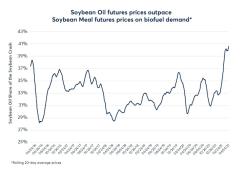
Source: CME Group data
Renewable Diesel in the U.S
RD is growing in importance globally. Unlike conventional biodiesel markets which are restricted by blending walls delineated by national fuel specifications, the blends in RD can contain up to 100% of the renewable feedstock. RD is also seen as a key product for manufacturing other products including sustainable aviation fuel, renewable naphtha and renewable propane.RD or HVO production is a growing market and Europe currently leads the charge on existing production capacity with about 4 million tons per year split between a small number of producers. However, the growth over the coming years is expected to come from the United States and Asia. The IEA estimates that around half of the planned increases out to 2025 will come from both regions. Total U.S production capacity of RD is expected to reach 10 million tons by 2024, an increase of 8 million tons from current levels, according to Bloomberg New Energy Finance. Global RD capacity is expected to reach 24 million tons by 2024.
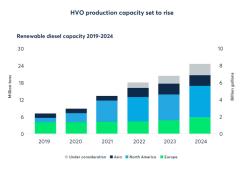
The Credits do the Talking
According to the latest RED II Directive in Europe, hydrotreated vegetable oil made from rapeseed, sunflower oil or soybean oil compare favorably with each other in terms of typical greenhouse gas savings (GHG). The Directive shows a saving of around 55%. Waste oil feedstocks yield higher savings with GHG savings of up to 87% for waste cooking oil and 83% from animal fats. For this reason, producers are paying particularly close attention to the second-generation feedstocks. However, it is worth pointing out that the waste oils remain in tight supply with many producers aiming to secure the same feedstocks for their production output.Carbon intensity levels vary according to feedstock choice. Typically, the waste feedstocks afford the producers higher carbon intensity credits compared to non-waste feedstocks such as vegetable oil or crop-based feedstocks. Under the California Low Carbon Fuel Standards legislation, the carbon intensity requirements increase over time meaning that the highest credits are only available for the more green and sustainable feedstocks. This may increase the pressure further on some of the key feedstocks that afford lower carbon intensity levels. CME Group offers futures on the Low Carbon Fuel Standard (LCFS) which is a financial product that allows customers to hedge exposure to the LCFS.
Waste Oils Market Set to Rise
The size of the waste market varies by operator, with ranges estimating from 20 million tons to 30 million tons per year. Barclays estimates that demand will increase by 19 million tons per year by 2030 suggesting that unless operators are able to double the size of the waste resources pool over the next 10 years, the market could experience a period of tightness.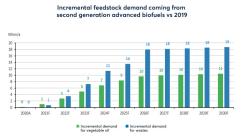
Read more articles like this at OpenMarkets






